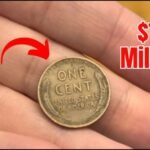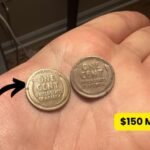Let’s face it—we rarely think twice about the coins rattling around in our pockets, sitting unnoticed in jars, or buried at the bottom of drawers. Over time, spare change becomes background noise in our day-to-day lives. But what if one of those tiny copper coins—one that might be resting in your wallet right now—turned out to be worth ₹380 crores (approximately $46 million)?
It may sound too fantastic to be true, but it isn’t. There is indeed a rare coin—the Lincoln Wheat Penny—that has fetched that kind of astronomical value. And the most surprising part? There’s a chance that one of these rare coins is still floating around in everyday circulation.
What is a Lincoln Wheat Penny and Why is It So Special?
The Lincoln Wheat Penny was first introduced in 1909, marking the 100th birth anniversary of the 16th President of the United States, Abraham Lincoln. It was not just any coin—it was a milestone in American numismatics. Prior to its release, U.S. coins featured symbolic representations, like Lady Liberty. The Lincoln Wheat Penny became the first U.S. coin to depict a real historical figure.
On the reverse side of these pennies, you’ll see two wheat stalks flanking the words “One Cent,” which gave rise to the popular nickname—Wheat Penny. These coins were minted from 1909 to 1958, after which the reverse design was changed to showcase the Lincoln Memorial.
While most Lincoln Wheat Pennies still carry their face value of one cent, there are rare variants that are worth millions today. The reasons for this lie in historical significance, minting errors, and limited production years.
How Can a Lincoln Wheat Penny Be Worth $46 Million?
Not all Lincoln Wheat Pennies are created equal. Certain variations are now prized collectibles, and their values have skyrocketed due to several key factors:
1. Minting Errors
Coins that have mistakes in their minting process are highly coveted by collectors. These errors can include:
- Double striking (where the image appears twice)
- Off-center images
- Coins made from the wrong metal blanks
Such anomalies make the coin unique and increase its value significantly.
2. Limited Production
Some Lincoln Wheat Pennies were produced in very limited quantities. In the world of coin collecting, scarcity often leads to demand—and demand means higher prices. For certain years and mint marks, very few specimens remain in circulation.
3. Historical Importance
Coins linked to major historical events or economic shifts become more valuable over time. The Lincoln Wheat Penny captures the spirit of an evolving America, especially during and after World War II, when coin materials were changed due to wartime needs.
4. The Legendary 1943 Copper Penny
During World War II, the U.S. government began producing pennies out of steel to conserve copper for war efforts. However, by mistake, a few 1943 pennies were minted using leftover copper blanks.
These copper 1943 Lincoln Wheat Pennies are now considered the “Holy Grail” among collectors. If you have one in pristine condition, you might just be holding a multimillion-dollar artifact.
Is the $46 Million Lincoln Wheat Penny Still in Circulation?
You might think that a coin worth that much would surely have been taken out of circulation by now—but you’d be surprised.
Many of these rare coins have unknowingly been used as everyday change. Others may be sitting forgotten in coin jars, piggy banks, or antique collections. Over the years, people have discovered valuable Lincoln Wheat Pennies in the most unexpected places—garage sales, flea markets, and even stuck between couch cushions.
So yes, it’s entirely possible that a valuable Lincoln Wheat Penny could still be out there, just waiting to be discovered.
How to Identify a Rare and Valuable Lincoln Wheat Penny
Think you might have a hidden treasure in your possession? Here’s how to find out:
1. Check the Date and Mint Mark
Some years and mint marks are far more valuable than others. Here are a few to look for:
- 1943 Copper Penny – If it’s made of copper and says 1943, it’s rare.
- 1909-S VDB Penny – The very first coin in the series, with the designer Victor David Brenner’s initials.
- 1944 Steel Penny – A reversal of the 1943 mistake; this time steel was used accidentally when copper was supposed to return.
2. Perform the Magnet Test
Steel coins are magnetic; copper ones are not. So if your 1943 penny doesn’t stick to a magnet, it might be made of copper—and that could make it one of the rarest Lincoln Wheat Pennies in existence.
3. Evaluate the Condition
A Lincoln Wheat Penny in mint or uncirculated condition is worth much more than one that’s heavily worn. Collectors are willing to pay top dollar for coins that appear untouched by time.
4. Look for Minting Oddities
Coins with double lettering, incorrect spacing, or a misspelled word can also be very valuable. Any kind of anomaly can increase a coin’s worth.
What Should You Do If You Think You Have a Rare Lincoln Wheat Penny?
1. Don’t Clean the Coin
It may be tempting to polish it up and make it shine, but don’t. Cleaning can significantly reduce the coin’s value. It’s best to leave it in its original condition.
2. Do Some Research
Compare your coin to images and descriptions on reputable websites or coin collectors’ forums. Learn about grading standards and market trends.
3. Get It Authenticated
To confirm its authenticity and condition, consider getting your coin evaluated by a professional grading service such as:
- PCGS (Professional Coin Grading Service)
- NGC (Numismatic Guaranty Corporation)
They can issue an official certificate of authenticity, which helps in commanding a better price during resale.
4. Sell Through Trusted Sources
If the coin is confirmed to be rare, sell it through a reputable auction house or a certified coin dealer. Avoid general selling platforms like eBay, where you might not get the coin’s true value.
Conclusion
It’s genuinely amazing to think that something as small and ordinary as a penny could hold such immense value. The Lincoln Wheat Penny has a rich history, fascinating design, and in rare cases—staggering monetary worth. With minting errors, historical value, and scarcity all playing a part, these coins have become some of the most desirable collectibles in the world.
So the next time you empty your pockets or crack open an old piggy bank, take a closer look at those forgotten pennies. There’s a chance—however slim—that one of them might just be the elusive $46 million Lincoln Wheat Penny. And who knows? Your spare change could change your life.
FAQs
Q1. Is there really a Lincoln Wheat Penny worth $46 million? Yes, there are verified reports and claims from collectors that a particular 1943 copper Lincoln Wheat Penny, in nearly flawless condition, was appraised at $46 million due to its rarity and condition.
Q2. What makes the Lincoln Wheat Penny so valuable? The Lincoln Wheat Penny’s value stems from a combination of factors—limited mintage, minting errors, historical significance, and high collector demand. Special variants like the 1909-S VDB or the 1943 copper penny are exceptionally rare.
Q3. Could a valuable Lincoln Wheat Penny still be in circulation? Surprisingly, yes. Some rare coins have never been officially pulled from circulation, which means you could still stumble upon one in everyday change.
Q4. How can I identify a valuable Lincoln Wheat Penny? Look for coins with rare mint marks, unusual dates, or minting anomalies. Also consider the coin’s condition—mint state coins are the most valuable.
Q5. Which Lincoln Wheat Penny years should I look for? Focus on coins minted between 1909 and 1958. Key dates include 1909-S VDB, 1914-D, 1922 no D, 1943 copper, and 1955 doubled die.
Start your search today—you never know what history (and fortune) might be hiding in your coin jar.
Some Important Link
| Telegram Group | Click Here |
| WhatsApp Group | Click Here |
| Home Page | Click Here |



